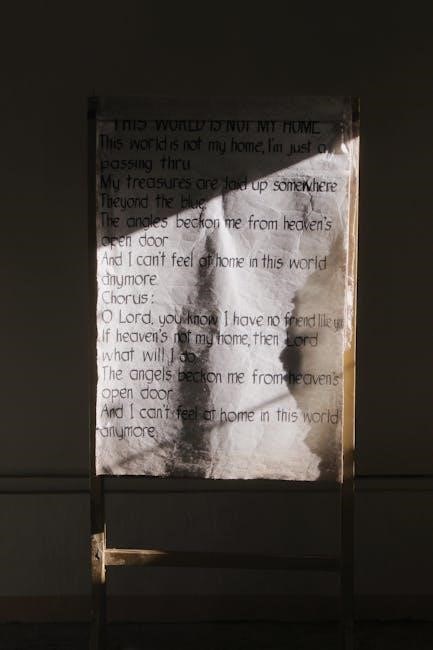Historical Background of “My Country, Tis of Thee”
Written by Samuel Francis Smith in 1831, “My Country, Tis of Thee” served as the de facto national anthem until 1931, set to the tune of “God Save the King.”
1.1 The Song’s Role as a De Facto National Anthem
My Country, Tis of Thee was widely regarded as the unofficial national anthem of the United States for nearly a century. It first gained popularity in 1831 when Samuel Francis Smith wrote the lyrics, which were set to the familiar tune of God Save the King, the British national anthem. The song quickly resonated with Americans, becoming a patriotic standard at public events, celebrations, and governmental functions. Its adoption as a de facto anthem reflected the young nation’s desire for a unifying musical symbol. The song’s themes of liberty, heritage, and national pride deeply connected with the American people. It remained in this role until Congress officially designated The Star-Spangled Banner as the national anthem in 1931. Despite this, My Country, Tis of Thee holds a significant place in American cultural history.
1.2 The Composer and Lyricist: Samuel Francis Smith
Samuel Francis Smith, born in 1808, was a Baptist minister, journalist, and author who penned the iconic lyrics of My Country, Tis of Thee in 1831. At just 24, while studying at Andover Theological Seminary in Massachusetts, Smith crafted the patriotic verses that would resonate deeply with the American spirit. His lyrical masterpiece, set to the tune of God Save the King, the British national anthem, celebrated themes of liberty and national heritage, quickly earning its place as a de facto national anthem. Smith’s dual career in ministry and journalism likely influenced his poetic style and thematic choices, cementing his legacy as a pivotal figure in American cultural history.

Lyrics and Structure of the Song
The song’s patriotic lyrics celebrate liberty and national heritage, with verses and a chorus structured to evoke pride and unity, set to a familiar melody.

2.1 Complete Lyrics of “My Country, Tis of Thee”
My Country, Tis of Thee
My country, ’tis of thee,
Sweet land of liberty,
Of thee I sing;
Land where my fathers died,
Land of the pilgrims’ pride,
From every mountainside
Let freedom ring!
My native country, thee,
Land of the noble free,
Thy name I love;
I love thy rocks and rills,
Thy woods and templed hills;
My heart with rapture thrills,
Like that above.
Let music swell the breeze,
And ring from all the trees
Sweet freedom’s song;
Let mortal tongues awake;
Let all that breathe partake;
Let rocks their silence break,
The sound prolong.
Our father’s God, to thee,
Author of liberty,
To thee we sing;
Long may our land be bright,
With freedom’s holy light,
Protect us by thy might,
Great God, our King.
2.2 Analysis of Key Verses and Their Significance
The lyrics of My Country, Tis of Thee are rich with patriotic imagery and emotional depth. The opening verse, “My country, ’tis of thee, / Sweet land of liberty, / Of thee I sing”, establishes a tone of reverence and pride, celebrating America as a symbol of freedom. The line “Land where my fathers died, / Land of the pilgrims’ pride” connects the present to the nation’s historical roots, honoring the sacrifices of ancestors. The refrain “Let freedom ring” becomes a powerful rallying cry for liberty and unity. Later verses, such as “I love thy rocks and rills, / Thy woods and templed hills”, evoke a deep affection for the land itself, blending natural beauty with national identity. The final verse, addressing “Our father’s God”, ties freedom to divine providence, emphasizing moral and spiritual foundations. Together, these verses create a timeless ode to America’s values and heritage.

Musical Composition and Melody
The melody of My Country, Tis of Thee is adapted from the tune of God Save the King, the British national anthem, composed by Thomas Arne in 1740. The familiar tune was paired with Samuel Francis Smith’s patriotic lyrics in 1831, creating a harmonious blend of music and poetry that resonated with American values and identity, fostering widespread acceptance and emotional connection.
3.1 The Tune’s Origin and Its Connection to the British National Anthem

The melody of My Country, Tis of Thee originates from the British national anthem, God Save the King, composed by Thomas Arne in 1740. This iconic tune was widely recognized and cherished in the British Empire, symbolizing loyalty and patriotism. When Samuel Francis Smith wrote the lyrics for My Country, Tis of Thee in 1831, he intentionally set them to Arne’s familiar melody, leveraging its emotional resonance. The adaptation created a powerful connection between the British and American cultural heritages, while the new lyrics infused it with distinctly American themes of liberty and pride. This shared musical foundation helped the song gain rapid acceptance and popularity in the United States.
3.2 Musical Notations and Sheet Music Availability
Musical notations for My Country, Tis of Thee are widely available in various formats, including PDF files and printable scores. These resources often include piano arrangements, guitar chords, and vocal melodies, making it accessible for performers of all skill levels. Many websites offer free downloads of the sheet music, while others provide interactive versions for educational purposes. MIDI files are also accessible, allowing for digital playback and practice. The song’s traditional melody, set to the tune of God Save the King, ensures its compatibility with a range of instruments. Whether for personal use or public performance, the sheet music remains a popular choice for celebrating American heritage and patriotism.

Cultural Impact and Legacy
My Country, Tis of Thee has profoundly influenced American patriotism, fostering a sense of national identity and unity. Its enduring legacy continues to resonate in cultural celebrations and historical commemorations.

4.1 The Song’s Influence on American Patriotism

My Country, Tis of Thee has long been a powerful symbol of American patriotism, inspiring national pride and unity. Written by Samuel Francis Smith in 1831, the song became an unofficial anthem, celebrating the nation’s history and values. Its lyrics, emphasizing liberty and the sacrifices of forefathers, resonated deeply with the American people. The song’s adoption as a de facto national anthem before The Star-Spangled Banner solidified its role in fostering patriotism. It has been sung at numerous historical events, schools, and public gatherings, nurturing a sense of shared identity and love for the country. Its enduring popularity reflects its ability to evoke emotional connections to America’s heritage and ideals.
4.2 Modern-Day Performances and Adaptations
My Country, Tis of Thee remains a cherished piece in modern performances, often featured at patriotic events, schools, and cultural ceremonies. Its timeless melody and lyrics continue to inspire new generations, with adaptations across various musical genres, from classical to contemporary arrangements. Many artists have recorded the song, blending traditional and modern styles to keep it relevant. Additionally, the song’s melody, shared with the British national anthem, has been creatively reimagined in jazz, rock, and instrumental versions. Its availability in PDF and MIDI formats has further facilitated its use in educational and communal settings. This enduring piece continues to unite people, celebrating American heritage while evolving with the cultural landscape.

Resources and Downloads

Access PDF files, MIDI files, and printable scores of My Country, Tis of Thee online. Guitar chords, piano arrangements, and sheet music are also available for download and personal use.
5.1 PDF Files and Printable Scores
PDF files and printable scores of My Country, Tis of Thee are widely available online. These resources include the full lyrics, musical notation, and arrangements for various instruments. Many websites, such as hymnary.org and in2lonline.com, offer free downloads of PDF versions of the song. These files are ideal for personal use, educational purposes, or community performances. The printable scores are neatly formatted, ensuring clarity and ease of reading. They often include chord charts and piano arrangements, making them versatile for musicians and singers. Whether for patriotic events or historical studies, these PDF files and scores provide a convenient way to access and share the beloved anthem.
5.2 Guitar Chords and Piano Arrangements
Guitar chords and piano arrangements of My Country, Tis of Thee are popular among musicians and singers. These arrangements are available in various formats online, catering to both beginners and experienced performers. The chord charts provide a simple yet effective way to accompany the song, while piano arrangements offer more complex harmonies. Websites like hymnary.org and in2lonline.com offer free downloads of these arrangements. The song is often played in the key of F major, making it accessible for most instrumentalists. These resources are ideal for patriotic gatherings, school performances, or personal practice, ensuring the melody remains timeless and enjoyable for all.
